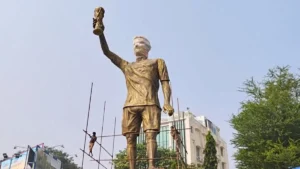In a remarkable display of talent and dominance, Indian para-athletes excelled in the javelin throw events at the Asian Para Games in Hangzhou, China, with Sundar Singh Gurjar breaking a world record and Sumit Antil successfully defending his gold medal.
In the men’s javelin throw-F46 final, India’s Sundar Singh Gurjar delivered an outstanding performance, breaking the world record with a throw of 68.60 meters. This incredible achievement not only secured him the gold medal but also surpassed the previous world record held by Sri Lankan Dinesh Priyantha at 67.79 meters. Sundar’s throw also set new Games and Asian Records.
India’s Podium Sweep
India’s dominance in the men’s javelin throw-F46 event was further highlighted as they secured a podium sweep. Rinku and Ajeet Singh, while not breaking the world record, displayed their excellence by throwing distances of 67.08 meters and 63.52 meters, securing silver and bronze medals, respectively.
Sumit Antil’s Exceptional Defense
Reigning Olympic and world champion Sumit Antil put up a stellar defense of his gold medal in the men’s javelin F64 event. In his first throw, he easily shattered the Games Record with a distance of 66.22 meters, surpassing his previous record set in 2018. His second throw came close to his world record of 70.83 meters, measuring 70.48 meters.
Antil’s World Record Break
Sumit Antil’s astounding performance reached its pinnacle in his third attempt, where he unleashed a colossal throw of 73.29 meters, surpassing his own world record set at the World Para Athletics Championships in Paris earlier in the year. This feat not only solidified his gold medal position but also established a new world record.
Indian Para-Athletes Shine
The exceptional performances of Sundar Singh Gurjar and Sumit Antil, along with the podium sweep in the F46 category, are a testament to the remarkable talent and dedication of Indian para-athletes. Their achievements at the Asian Para Games inspire and elevate the nation’s standing in the world of para-sports.




 U-19 Asia Cup Schedule 2025: Full List o...
U-19 Asia Cup Schedule 2025: Full List o...
 U-19 Asia Cup 2025, Vaibhav Suryavanshi ...
U-19 Asia Cup 2025, Vaibhav Suryavanshi ...
 70-Foot Iron Statue of Lionel Messi Unve...
70-Foot Iron Statue of Lionel Messi Unve...







